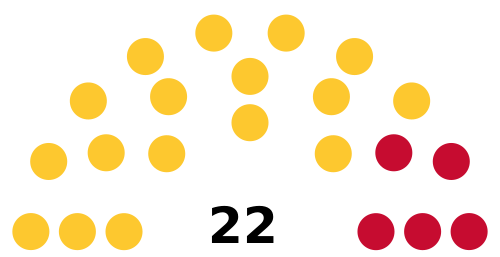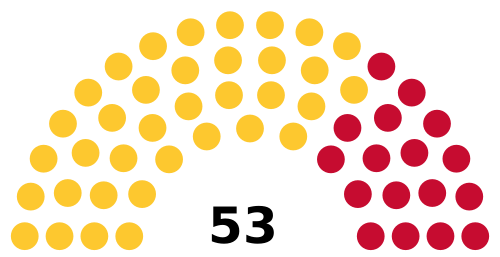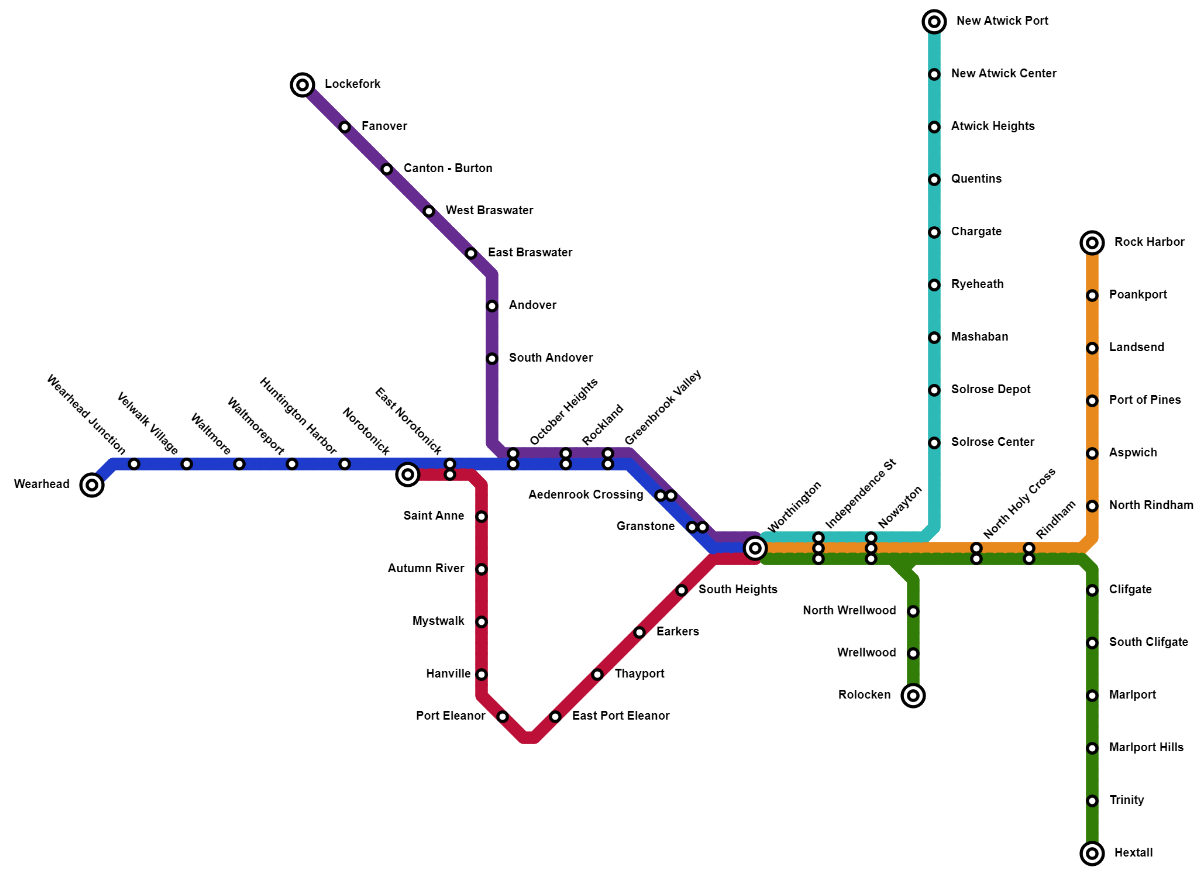Hyde
| Commonwealth of Trinity Island Trinity Island | |||
|---|---|---|---|
| |||
Loading map... | |||
| Constituent state of | |||
| Capital and largest city | Worthington | ||
| Official languages | Ingerish | ||
| Demonym | Trinitian | ||
| Government | |||
| • Governor | Diane Walsh | ||
| • Lt. Governor | Richard Evans | ||
| Legislature | General Assembly | ||
| • Upper house | Senate | ||
| • Lower house | House of Representatives | ||
| Area | |||
| • Total | 10623.51 km2 4101.76 sq mi | ||
| Population | |||
| • Estimate | 1,432,784 | ||
| • Density | 134.9/km2 | ||
| HDI (2020) | very high | ||
| Timezone | WUT +10 | ||
Trinity Island (ˈtrɪnəti ˈaɪlənd), officially the Commonwealth of Trinity Island, is a constituent state in Southeastern Federal States. It is one of the smallest FSA state by area, with an area of 4101.76 sq mi (10623.51 km2), and also one of the least populous, with about 1.4 million inhabitants as of 2020. The state is named after the eponymous island, which constitutes a large part of its territory. Trinity Island borders on the Ardentic Ocean to the east, Passamaqueets and Thermond to the north, Astrantia to the west, Perchorsee Isles Nature Reserve and the Perchorsee Bay to the south. Worthington is the state capital and most populous city.
Etymology
The state is named after Atwick Island, called in Colonial times as Trinity Island. The most widespread version of the origin of the name. The name is attributed to Charles Quentins, one of the first bishops of the Federal States, who argued that the name arose after having survived a terrible storm on the high seas and having miraculously arrived on the island. Andrew Fletcher, captain of the Atwick, attributed his arrival to the island to the prayer to the Holy Trinity that the religious group (led by Quentins) made a few moments ago, and therefore gave the island and the subsequent colony that name. The name was made official by Ingerland for the entire colony shortly after.
The name remained in use for the state after the independence of Ingerland, and it was also approved to name the main island as Atwick Island to differentiate it from the state.
History
Pre-colonization
Colonial period
18th century
19th century
20th century
21st century
Geography
Trinity Island is one of the smallest states in the Federal States. It is located in the Southeast Region of the country and has an area of 4,102 sq mi (10,624 km2). Several bays distinctly shape its coast. Worthington is the largest city, at the middle of the Atwick Sound and the mouth of the Green River.
Despite its small size, Trinity Island features numerous topographically distinctive regions. The Insular Trinity Island is composed of the 3 major islands of the state (Atwick, St. Mary and Holy Island) and other adjacent small islands and islets. The large coastal plain of the Ardentic Ocean and the Perchorsee Bay, known as Coastal Trinity Island, contains the major cities of the state (excluding New Atwick): Worthington, Port Eleanor and Wearhead. Most of the remaining zones are divided into two regions: the Autumn River Valley and the Foryoke River Valley, whose limit is bounded by the former Worthing and Wandsport counties border. Along the border with Thermond and a section with Passamaqueets is the Norottuck region, which includes the highest points in the state and the Trinity Island's section of Norottuck Watershed.
Climate
Administrative divisions
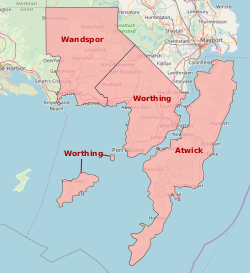
There are 61 municipalities in Trinity Island, grouped into 3 counties. The three counties, moving from west to east, are Wandsport, Worthing and Atwick. Trinity Island has no county governments, same as other Southeast Region states; instead, municipalities hold many of the responsibilities and powers of local government. Trinity Island county governments were abolished by the state legislature in 1964. The three counties are still used only for purely geographical and statistical purposes. There are three non-permanent councils of government in which the leaders of all municipalities of the former three counties meet to discuss emergency measures, collective security threats and works between municipalities.
Of the 61 municipalities of the state, 13 are from Atwick County, 24 from Worthing County and also 24 from Wandsport County. They are the fundamental political entities of the state. All the 49 municipalities named as towns have a town meeting system, while the remaining 12 municipalities named as cities (New Atwick, Worthington, Earkers, Port Eleanor, Greenboro, Stoneham, Islington, Rockland, Autumn River, Saint Anne, Waltmore and Wearhead) have a mayor-council government, in which the city is leaded by an elected mayor.
The town meeting is the system of government used by all the towns in the state according to the state constitution, in which most or all of the members of a community come together to legislate policy and budgets for local government. The mayor-council government is the system used by all the cities in the state, where there is an executive mayor and a city council which are elected by the voters.
| County | Municipalities | Area in km² | Area in miles | Population | Pop. density in km² | Established | Map |
|---|---|---|---|---|---|---|---|
| Atwick | 13 (list) | 6051.39 | 2336.46 | TBD | TBD | TBD | Map∈⊾ |
| Wandsport | 24 (list) | 1537.59 | 593.67 | TBD | TBD | TBD | Map∈⊾ |
| Worthing | 24 (list) | 3034.53 | 1171.64 | TBD | TBD | TBD | Map∈⊾ |
Government and politics

The capital of Trinity Island is Worthington. The state is organized into three branches of government—the executive branch consisting of the governor, the Governor's Council, the cabinet and other independently elected state constitutional officers; the legislative branch consisting of the Senate and the House of Representatives; and the judicial branch consisting of the Trinity Island Court System. The state also allows ballot propositions: direct participation of the electorate by initiative, referendum, recall, and ratification. All the state constitutional officers, including the governor and lieutenant governor, are directly elected.
Both houses of the Trinity Island State Legislature meet at the Trinity Island State House (map); in the center of the same building are located the governor's office and the Governor's Council seat. Most important offices of the state's executive branch are located in the James A. Sutton (map) and Charles M. Tremont (map) federal buildings. The Supreme Court (map), the Department of Justice (map) and the General Court of Worthington (map) are located in the Tremont Plaza, the center of the area known as the "Judicial Block" of Worthington.
Executive branch
The governor heads the executive branch. Its primary duties include lead the cabinet, signing or vetoing state legislation, filling executive agencies appointments, granting pardons, preparing an annual budget and commanding the Trinity Island National Guard. The executive branch also includes the Governor's Council, which is composed of three elected councilors (which also exercise as ex-officio chairs of the councils of government) and the lieutenant governor. The council provides advice and consent in all matters – primarily nominations, minor contracts, pardons, and commutations – to the governor.
In addition to the governor, lieutenant governor and the members of the Governor's Council, the executive branch is composed of a state cabinet appointed by the governor, and other elected constitutional officers: attorney general, secretary of state, comptroller, treasurer, insurance commissioner and superintendent of public instruction. All these officers serve 4-year terms and may be re-elected only once.
Statewide elected officers
| Portrait | Name | Party | Role | Previous elected office(s) | Biography | |
|---|---|---|---|---|---|---|

|
Diane Walsh | CP | Governor of Trinity Island since TBD |
TBD | [As soon as possible, here you will find the biography of this statewide elected officer. Therefore, consider this as a spaceholder.] | |
| Governor's Council | ||||||

|
Richard Evans | CP | Lieutenant Governor of Trinity Island since TBD |
TBD | [As soon as possible, here you will find the biography of this statewide elected officer. Therefore, consider this as a spaceholder.] | |

|
Michael Wolf | FDP | Member of the Governor's Council from Atwick County since TBD |
TBD | [As soon as possible, here you will find the biography of this statewide elected officer. Therefore, consider this as a spaceholder.] | |

|
Rebecca Bennet | CP | Member of the Governor's Council from Worthing County since TBD |
TBD | [As soon as possible, here you will find the biography of this statewide elected officer. Therefore, consider this as a spaceholder.] | |

|
Calvin Walton | CP | Member of the Governor's Council from Wandsport County since TBD |
TBD | [As soon as possible, here you will find the biography of this statewide elected officer. Therefore, consider this as a spaceholder.] | |
Legislative branch
The Trinity Island State Legislature consists of the Senate (upper house) and the House of Representatives (lower house). The House has 53 members while the Senate has 22 members. The leaders of the House and Senate are appointed by the members of those bodies; the leader of the House is known as speaker while the leader of the Senate is known as president. Each chamber consists of several committees. House members are elected to 2-year terms, while senators are elected to 4-year terms.
Current composition of the State Legislature
Judicial branch
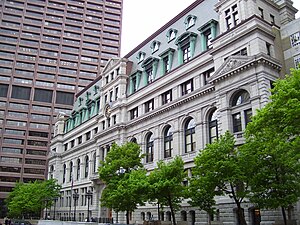
The highest court of Trinity Island's judicial branch is the Supreme Court of Trinity Island (map), headed by the Chief Justice of Trinity Island. It is composed of 7 justices who are appointed by the Governor and confirmed by the Senate for life or until their resignation. The Supreme Court is responsible for deciding on the constitutionality of the law or cases related to the law. The Trinity Island Court System, in addition to the Supreme Court (which is the fourth level), consists of 3 levels of courts.
The first level are the judicial commissions, the primary law institutions of each town (and borough in the cities) that consists of residents appointed by the town meetings. They have the responsibility to resolve conflicts between residents and formalize the actions of the town police. The second level are the general courts, which are the first penl level in the system. They are responsible for determining sentences, and evaluating the constitutionality and legality of the decisions of the judicial commissions. It is also the first level formed by justices and its jurisdictions can include several towns together, a single city or a city and several towns, which have to be under the same appellate court jurisdiction.
The third level, immediately below the Supreme Court, are the Courts of Appeal. With jurisdictions corresponding to the former counties boundaries, they are the primary appellate courts within the state. Same as the previous level, they are composed of justices that are appointed (like the justices of the general courts) by the Governor.

